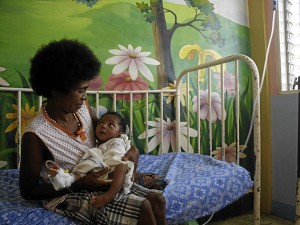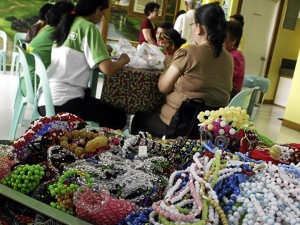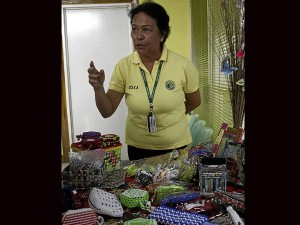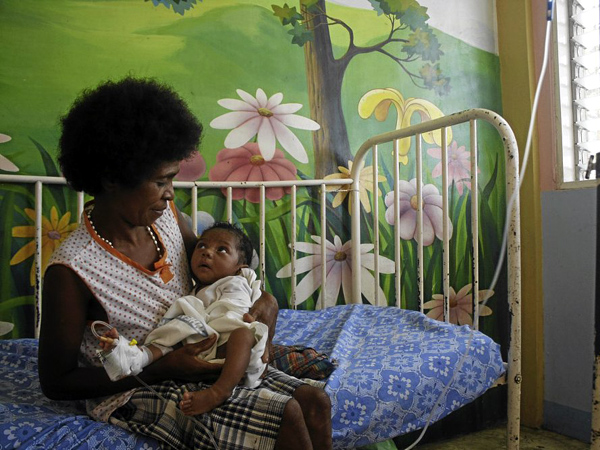On top of that, this hospital ward in Porac is notable for adapting to the needs and cultural beliefs of its beneficiaries. As is their custom, kapatad families cluster around their sick member, offering comfort and company as well as hot meals cooked over an open fire in the hospital grounds. At the pedia ward, a mom-and-pop tandem and two babies fold themselves artlessly onto the sick child’s bed, their feet dangling over the edge.

The group has also been given space to tend a herbal garden for all sorts of ailments ranging from high blood to diabetes, and are allowed to wash their clothes at the hospital. The kapatad, says Nurse Padua, had excitedly declared the hospital’s running water as far superior to the river when they usually do their laundry.
Indeed, the ward’s gaily painted walls approximate the homescape that the kapatad have temporarily left for medical treatment, the mural portraying lush fields, wild flowers in full bloom and hazy mountains in the distance. There is no electric fan or air-conditioning, but the wide open windows and a wraparound terrace provide natural lighting and ventilation. There used to be a TV set and some sofas in the receiving room, Nurse Padua volunteers, but they were no match for the kids who watched TV 24 hours a day. The sofa-turned-improvised trampoline must soon be replaced, too, suggests Dr. Rory Siasoco, Senior Project Manager of SM Foundation. “Perhaps wooden benches would be better?” she adds.
Despite the mishaps, the kapatad have come a long way, the chief nurse concedes, from those days when patients preferred sleeping on the hospital’s hard ground and once built an open fire inside their ward to cook rice.
Some customs have remained however, like the ubiquitous magtatawas (native healer) who diagnoses kapatad patients first before they take the P100 tricycle ride to the hospital. “If the patients are brought in for emergency and haven’t had a tawas session, they ask the healer to come to the facility instead to do the rituals on them,” Nurse Padua says. The hospital staff don’t object, she adds, lest they get blamed should the ailment worsen.

Most of the kapatad come to the ward for common illnesses: diarrhea, fever, the occasional pneumonia and TB. And for childbirth, adds the chief nurse, eyeing Michelle Mesa, 28, who is pregnant with her fifth child and whose 11-year-old eldest girl is shyly hiding behind her. Michelle’s urbanized name is an exception, Dr. Siasoco explains. Most kapatad still name their children based on what they hear first, she says, adding that she has heard of kapatad babies called “Cottonballs” or “Marimar” and can only imagine what the circumstances were at the time of their birthing.

‘Ondoy’ no match for these women
Over at the Marikina Riverbanks, typhoon “Ondoy” proved itself no match to the determination of a group of elderly women to retrieve their rest and recreation center. “Ondoy’s” wrath had flattened the original two-story structure provided by the World Health Organization, but it was rebuilt in 2009 by the SM Foundation.
“Ondoy” was the only time I was absent for the past three years,” proudly states Normita Centeno, 65, one of the 20 to 30 regulars at the Felicidad Sy Wellness Center for the Elderly. The building has a pocket exercise yard out front, a spacious work area, a library, stock room and a comfortable lounge.
Today, six or seven elderly women are busy threading beads into purses, necklaces, rosaries, ID and pen holders, and folding bags from recycled paper to fill up Christmas orders from several parishes and NGOs. Presiding over this ersatz H.E. class is Angelita Dipasupil, 61, a livelihood trainer who used to be a supplier of handicrafts to SM malls.
“This,” says Dipasupil, hoisting up a cheery bag from recycled materials, “is what the women call their Louie Bitoy bag.” She adds proudly: “I teach them the basic steps but they have surpassed me in creativity.”
Most of the women are widows, and regard the crafts as a welcome diversion from their aches and pains and the stress and loneliness of living alone. Most of their children are living abroad or have their own families, explains Dipasupil. But the women also gain a lot from the experience, she adds. They’ve learned to manage their capital and earnings from the crafts, with one woman, Lourdes Mari, 71, assigned to buy materials from Divisoria. “The activity also stirs up their imagination and creativity, and they’re not afraid to experiment and play with colors,” says Dipasupil.

“Well, after all, this is the Above 60 Academy,” says Anita Paningbatan, 64, of the new skills she’s learned from the Center. Theda Asis, 64, nods her assent.
Of course, says Dipasupil, most of the women become so attached to their creations that they refuse to sell them. “They always keep the first project.”
Aside from crafts, the women enjoy other services offered by the Center including line-dancing, twice-weekly ballroom dancing, free or discounted medical lab tests, tai chi, qi gong and bingo. Rose Lopera and Letty Farinas, both in their sixties, love the ground golf, while it is aerobics that keeps her coming back, says Adelina Lagos, 67. This woman, who is described by fellow seniors as “mahilig gumiling-giling (she loves to gyrate),” gamely gives an impromptu show upon her friends’ prodding, while Nay Lourdes Mari breaks into a plaintive kundiman.
The women also hold a monthly party for birthday celebrants, the potluck lunch becoming a strong bonding session among them. Every last Saturday of the month, there is a seminar on various topics at the Center. In November, a poster tacked on an outside wall invited other seniors to a seminar on “Preventing and Treating Cancer Naturally”.
Thanks to Office of Senior Citizens Affairs president Rodolfo de Guzman, 82, the women also get free vaccinations for flu. Well, it doesn’t hurt that Tatay Ruding’s son is Marikina mayor Del de Guzman, who has provided the funds for the vaccine given to some 7,000 elderly beneficiaries.
People think that seniors are always grumpy, and sometimes the women do get crabby, says Dipasupil. “But I always tell them, pauwi na tayo, dapat bumait na tayo (We’re on the homestretch of our journey. Let’s be good, there’s not much time).”
Wingless Angels comfort the afflicted
The thought of leaving permanently is a constant at the Felicidad Sy Hospice Care in Lucena, Quezon. The hospice at the Quezon Medical Center is run by volunteers, retired doctors and nurses who call themselves The Wingless Angels of Lucena Hospice, Inc. They regularly visit and comfort the terminally ill, says the group’s president, Dr. Lina Pagkatipunan. The volunteers include retired chief nurse Lydia A. Reyes, who used to be the executive director of the Cancer Society and oncologist Dr. Gina Pagkatipunan-Motil. Staff nurse Chiqui Labitigan, says Dr. Pagtipunan, makes sure the clinic is open from 9 a.m., and ready to receive terminally-ill cancer patients referred by the QMC or are walk-ins.
It was the nurse in her that wouldn’t quit, explains Reyes, 84, of her initiative to start the hospice in 2001 and invite volunteers to help out. They have 23 patients now, with the ambulatory ones dropping by to get their medication, while the rest gets home visitations, counseling from priests and painkillers as needed.
“The priests are in civilian clothes,” clarifies Dr. Siasoco. “We don’t want to alarm the patients and their families into thinking that the priest is there to administer the last rites.
Much has changed since the group started home visitation, says Dr. Motil. “It used to be that the family would shush us when we arrive because they don’t want the patient to know about the cancer, or vice-versa. Sometimes it’s the patient who doesn’t want the family to know. There was a stigma to cancer then, with people thinking it was the result of kulam (witchcraft). Now people are more aware and more informed about cancer so there’s less secrecy about it these days.”
Of course, the oncologist adds, some families still rely on faith healers before consulting medical doctors. “I have nothing against faith healers,” she says. “We have antibodies that are strengthened by faith so in a way, the belief in faith healers provide patients a better coping mechanism. So we don’t scold patients; we don’t want to antagonize them.”
But faith is not enough, Dr. Motil says, citing a friend who died of cancer though it was only on stage 1 when discovered. Instead of following medical protocol, this friend relied on prayers alone. They did not save her, the doctor says.
Another challenge that these wingless angels face is the family’s resistance to morphine as it could be addictive. “We give terminally-ill patients morphine to ease the pain,” says Dr. Motil. “But morphine is a prohibited drug and you need a special license to prescribe it. Relatives used to have reservations about it, saying they don’t want the patient to be addicted to the drug. Yes, it is addictive but also palliative. It makes the patient comfortable and improves the quality of life in their last few days. At di namin ipagkakait yun (and we’re not about to deprive them of that).”
The question she most dreads though is the inevitable, “Doc, how much time do I have?
She weighs her answer carefully, says Dr. Motil. “Di ako nagbibigay ng taning (I don’t give a definite timeframe). I tell them, hanggang buhay, may pag-asa (there’s always hope as long as you live).”
Nurse Chiqui Labitigan is often confronted with the same question but handles it differently. “I tell them to continue praying, because nothing is impossible.”
Josefina Osongco, 52, a stage 4 cervical cancer survivor, agrees. “Gusto kong mabuhay, so pag sinabi ng doktor na dapat akong magpa-chemo, sige lang, kahit magastos (I want to live so if the doctor says I should have chemo, I go and obey, despite the expenses involved).”
Of course, Osongco adds, “I have also accepted that I can go anytime.”
Her fellow patient Perla Paz says she is similarly resigned to her fate, having accepted the possibility of death since she was found with ovarian cancer in 2006. But this widow says she continues to seek medical care, even “living like a beggar, cadging food from strangers and slipping into wards so she could use the CR (comfort room)” at the Philippine General Hospital grounds for 10 days, while waiting for her scheduled consultation. “I couldn’t go home and come back again because I didn’t have enough fare money from Lucena to Manila and back,” she says. When she was finally scheduled for a surgery in 2008, the doctor looked for her companion and found none. “Gusto ng doktor may bantay ako (the doctor first wanted me to have a watcher to run errands for me, give me my medication, etc.) But to bring one would mean double the fare and money for food, which I don’t have.”
Alone and working as a laundrywoman and selling native sweets despite her cancer-swollen belly, Paz says she is still waiting for a benefactor to fund a hospital watcher that would finally push doctors to schedule her surgery and possibly extend her life.
Sadly, says Reyes, money remains the biggest bane of most cancer patients. “Even in government hospitals like PGH, treatment is not totally free.”
Going home for a final journey is never an easy thought for most patients, especially the terminally-ill, but hospice care, such as those provided by Lucena’s Wingless Angels with support from SM Foundation, certainly helps.









































